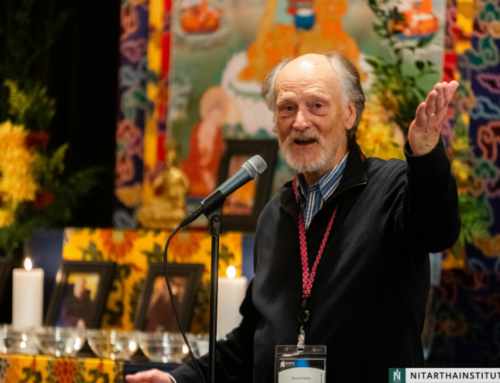How To Practice In This Time Of Strife
Part I:
In this time of strife and war there is desire in the practitioner to send positive thoughts of compassion, some prayers. But there might also be a strong tendency to show anger, and blame one of the sides. And, what would be a guidance here, utilizing what we have studied here at Nitartha in the real world situation like this we could benefit from? How do we make this practice?
The dharma of our teacher, Gautama the Buddha, the Tathāgata, the fully enlightened Buddha Śākyamuni, is the dharma of dependent origination, pratītyasamudpāda. The original formulation of the dependent origination by the Buddha is in Samyutta Nikāya:
“This being, that exists. From the arising of this, that arises.”
Then Nāgārjuna in Vigrahavyāvartanī 22 equates pratītyasamudpāda with emptiness, śūnyatā:
“Dependently arisen entities
Are called emptiness,
Because that which is dependently arisen
Is without nature.”
Dependent origination in essence is the teaching that the realities of the perceiver and perceived are not established independently of each other; rather, they are established in dependence on each other. What is perceived is established in dependence on the perceiver, and the perceiver is established in dependence on what is perceived. One cannot be without the other. Nāgārjuna, in Madhyamakaśāstra 10:10, brings this mutual dependent relationship to its logical conclusion:
“If one thing is established in reliance [on another,]
And if that [other thing]
Is also established in reliance on it,
What is established in reliance on what?”
This theoretical statement of mutual dependence of the perceiver and what is perceived can be brought into an immediate practice directly through observing the process of breathing, mindfulness of breathing. How is mindfulness of breathing practiced? The Buddha gives the famous instruction in the Nikāyas:
“And what, Ānanda, is mindfulness of breathing? Here, bhikkhu, having gone to the forest, to the foot of a tree, or to an empty hut, sits down. Having folded his legs crosswise, straightened his body, and established mindfulness in front of him, just mindful he breathes in, mindful he breathes out.”
The interdependence of the perceiver and what is perceived is brought into an immediate practice directly through mindfulness of breathing, specifically the technique of following the distance of the breath: beathing out, mixing with space, breathing in, permeating the body. The outer and the inner are dependent on each other. Breathing out and breathing in, mutually dependent on each other.
One cannot be without the other and this can be understood on many different levels. From the coarse level of understanding that without the oxygen in the atmosphere out there, the meditator would be dead in three minutes; and without the living beings, such as trees, there would also be no oxygen in the atmosphere. It goes both ways. Without a perceiver, there is no perceived. Without the perceived, there is no perceiver.
And, it can be understood on a more subtle, meditative level in the context of direct perception meditation, when the appearances are arising as not separate from mind as a result of such dependent relationship between the perceiver and the perceived, the observer and the observed, the inner and the outer, the individual and the environment, the body and the mind. Nāgārjuna in Dharmadhātustava 32 points out the unfortunate situation where we (the fools) keep clinging to the independent status of such realities in spite of constantly witnessing their dependent relationship:
“Since [such things] dependently originate
And in dependence too will cease,
If not even one [of them] exists,
How can these fools imagine them?”
The impossibility of any contact, any communication, or any connection between an independently existing perceiver and perceived is presented by Nāgārjuna in Madhyamakaśāstra 14.1-2, in the chapter called Examination of Connection:
“The three: the object seen,
Seeing, and the seer,
Do not make mutual contact
Either in pairs or all together.”
“So too attachment, and who is attached, and
The object of attachment, the remaining
Afflictions, and remaining āyatanas,
Should be examined in these three ways.”
The examination of connection in Madhyamakaśāstra is in agreement with Nitartha Institute’s root text Classifications of Mind by Khenpo Tsültrim Gyamtso Rinpoche. Rinpoche formulates the refutation of connection in the ultimate context, both for identical and causal connection:
“With regard to phenomena that are one in nature,
Two phenomena within the [actual] object are impossible.
If two phenomena within the [actual] object are not possible,
Connection within the [actual] object is impossible [too].”
“If there is an earlier and a later [entity], this contradicts simultaneity,
And [if they] are simultaneous, [this] contradicts causality.
Therefore, entities that are cause and result
Are not connected in terms of the [actual] objects.”
The impossibility of the independent existence of perceiver and perceived is also clearly explained in the presentation of reasons that prove their non-separation, in the Yogacara tradition, which we study in our Nitartha curriculum. Maitreya, in Dharmadharmatāvibhāga, refutes existence of any independently existing outer objects separate from the perceiving mind:
“What appear to be outer, perceivable in common,
Are perceiving awareness; they are not referents
Existing as something extrinsic to consciousness,
Because they are only [seemingly] experienced as common.”
And similarly, Śāntarakṣita in Madhyamakālamkāra 91:
“What are causes and effects
Are exclusively nothing but cognition.
That which is established by itself
Indeed remains cognition.”





